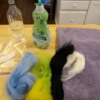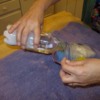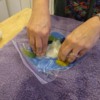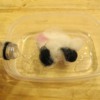Psalm 23: A Shepherd's Psalm
Art Workshop
Summary of Lesson Activities:
Children will use the technique of "wet felting" to create felted illustrations of the psalm. K-1 graders will use cookie cutters to make their wet-felted sheep.
Scripture References, Memory Verse, Theme and Objectives
Refer to first post in this lesson set.
Resources for the Workshop
- A Shepherd Looks at Psalm 23, Phillip Keller, Zondervan Publishing, Grand Rapids, 1970.
- Poster of Psalm 23 for each room.
Important note for Art workshop leaders:
In the Art workshop, the Bible story is reinforced through creative and hands-on art activities. The children may make something that they can take home to help remind them of the monthly theme or they may work together as a team to make something for the church to display.
During this rotation children practiced signing the psalm each week before class began. This was presented in worship service at the end of the rotation.
Leader Preparation and Room Set-Up:
- Review background information, teaching tips and lesson materials.
- Gather necessary supplies
- Cover the tables with the old tablecloths
- Print out a copy of the 23rd Psalm for each child
- Review the Music CD.
- Plan to play the music as the children arrive, work on their art projects and during journal time.
Supplies List:
Supplies for plastic baggie wet felting (grades 2-4, 5-6)
- Wool roving in a variety of colors (white, black, grey for sheep; green, blue, yellow for grass, water, sky and sun; pink, purple or red for flowers). Wool roving can be purchased online or from knitting and fiber arts suppliers. We purchased from Stony Mountain Fibers, AngelFire.com (now closed, sadly the owner passed away Sept. 2, 2016).
- Piece of craft felt
- Quart-size ziploc bags - one per child
- Hot and cold water
- Plastic water bottles - one per child
- Liquid dish washing soap
- Bath towels - one for each pair of children
- Cutting board
- A copy of the 23rd Psalm for each child
- Paper towels
Supplies for cookie cutter wet felting (grades K-1):
- Wool roving in a variety of colors (see source above)
- Sheep cookie cutters - one per child
- Plastic container large enough to hold the cookie cutter and several inches deep - one per child
- Plastic water bottles - one per child
- Hot, warm and cold water
- Thick hand towels/bath towels - one per pair of children
- Liquid Soap
- Embroidery floss (optional)
- Large needle (optional)
- Scissors (optional)
- Paper towels
Presentation
Opening-Welcome and Introduction
Welcome all children and introduce yourself. Make sure each child is wearing a nametag. Briefly describe and overview of the day's activities.
Opening Prayer
Please open each session with prayer.
Dear Lord, We thank you for this day and for all the people who guide and protect us. Teach us as we read your word and allow it to guide us also. Amen.
Important Teacher Notes:
Each workshop includes the Bible story. One of our primary goals is to improve the children’s Bible literacy! If children did not bring their Bibles from home, use the classroom Bibles. Shepherds should help the children locate the stories. Use the Background Information to help you introduce the story.
Remember that as the Rotation progresses; the children will become more familiar with the story. When this happens, allow the children to tell you what they know. The children should still locate the story in their Bibles every week. Use the bold headings in their Bibles to guide your discussion. You may want to review some of the Bible notes as well. Be sure to fill in any missing information and add additional details using the Background Information to help you. One of the greatest advantages of this model is that children who come regularly learn the story in great depth.
Each lesson contains more Background Information and discussion questions than can be used in one session. Remember, children are studying this story for four weeks! Be sure to follow the time guidelines and leave ample time for the activity.
Dig-Main Content and Reflection:
Introduce the Story - All Grades
What is a shepherd? (A person, who takes care of a lot of sheep, guides or leads the sheep, and keeps them safe. He has enough food and clean water for the sheep, keeps the sheep from being scared and makes sure they don’t get lost. Throughout the lives of the sheep, the shepherd walks with them as they travel from one place to the next. The sheep are never asked to guide themselves or find their ways alone.)
Who was King David? (He was chosen by God to be Israel’s king long before Jesus was sent to be the King)
If David lived long before Jesus, where would we find the stories about him in the Bible? (the Old Testament)
Does anyone know what job David held before becoming king? (He was a shepherd. That meant he understood how to lead and protect those that he was in charge of. Additionally, during the time he spent with the sheep, he became very close to God. He had a lot of time to think about life and all the gifts that God had given him. He learned patience and kindness and was able to see how God worked in his life.)
As David learned more about God, he realized that God is our shepherd. He is the one who should guide us. He is the one we should depend on every day of our lives for safety, for answers and for all that we need.
David had such a wonderful relationship with God that he wrote about it. He wrote songs for people to sing. In the Old Testament, they were called psalms. David wrote many psalms during his life. His most famous is probably Psalm 23.
Additional Information for older grades:
Sheep can easily follow another sheep if they don’t have a shepherd. The sheep cannot determine if the other sheep are leading them into danger or to a place that doesn’t have any food or water. They must follow a shepherd and trust him if they are to be safe. Additionally, sheep would happily follow the same paths over and over again even if it meant they ate all their food and/or if it became a dangerous place. If the sheep follow a shepherd, he will ensure that they change their path if it is not the best one for them.
A shepherd’s rod is used to protect the sheep. The shepherd would use it to gently guide the sheep, check for parasites on the sheep that would irritate them, and to gently scold them if necessary.
Bible Study: K-1
Let’s read the 23rd Psalm and think about being a little lamb with a shepherd as your leader.
Have the children turn to page 278 in The Picture Bible. Read "The Chosen One" from page 278 to the top of page 280 (stop after the first frame). This reviews David being chosen by God to be the new king and briefly mentions his work as shepherd and creating psalms. Next pass out the handout of Psalm 23. Read as the children follow along. Have the children close their eyes as you read the psalm a second time asking them to try to imagine every image described in the psalm.
Discussion:
- What is a psalm? (a song or poem written to express emotion to God)
- Who wrote Psalm 23? (David)
- Who did David say is his Shepherd in the Psalm? (God)
- What was David's job before he became King? (shepherd)
- Where in the Bible would we find Psalms? (Old Testament – about in the middle of the Bible)
Bible Study: Grades 2-5, 6-7
Bibles:
- 2-4 graders - NIV Adventure Bible, turquoise blue cover with embossed lizard
- 5-6 graders: NIV Adventure Bible, dark blue plain cover
Have the children locate Psalm 23 in their Bibles. Children with Bible ribbon bookmarks can use their blue ribbon to locate the books of poetry. The book of Psalms is found in about the middle of the Bible.
Hand out the copy of the 23rd Psalm and read it to the children. Read it a second time and ask them all to close their eyes. Ask them to try to visualize every image described in the psalm.
Read and discuss the following Bible notes:
- Words to Treasure: page 618
- Life in Bible Times: What God is Like, page 618
- Let’s Live It: God is My Shepherd, page 619
Memory Verse
Help the children locate the memory verse in their Bibles.
"The Lord is my shepherd, I shall not want…." Psalm 23
Encourage the children to memorize as much of the psalm as they can (at the minimum, K-1 graders should memorize the first line of the psalm. Older children should memorize several lines and hopefully the entire psalm). Children who participate in Worship Arts this month will learn to sign the psalm -- which will greatly help them with the memorization process. Children will present the signed psalm in worship!
Discussion questions:
- How is God like a shepherd? (cares for us, love us, gives us what we need, guides us)
- How are we like sheep? (we can be stubborn, want our own way, sometimes we wander off)
- What are some things that people do that show us that they’re not allowing God to lead them? (Lying, cheating, hurting others, saying mean things)
- How does a shepherd help calm the sheep? (keeps predators away, helps them stay calm, puts ointment on face to keep bugs away)
- How can God help to calm you when you are scared or worried? (prayer, reading about Bible people who were scared and God helped, talking with parents or good friends)
- How about when you are “bugged” by people or things?
- What does it mean to “restore my soul?” (a good feeling in your heart, a sense of safety and comfort)
- How did the shepherd “prepare a table” for his sheep? (got the pastures ready – removed the weeds, rocks and dangerous places)
- What table do we have here at church in our sanctuary? (Communion table)
- How does God prepare this table for us? (Christ had the Last Supper with his disciples, he died for us)
- What were the rod and staff used for? (to protect the sheep, to guide them, to pull them close to the shepherd)
- What brings us closer to God? (spending time with God, prayer, worship, study)
- What are some things that worry you or scare you? (Did you know that if you pray to God to help you and to guide you, he could lead you away from those fears and frustrations. It doesn’t mean that those things will completely go away, it does mean that if you pray and read the Bible, He can lead you to a point where it doesn’t bother you or scare you as much.)
- Has your soul ever been troubled? How has God "restored your soul?"
- What does this psalm teach you about God?
Wet Felting with Wool
Adapted from ideas at the following sites:
- http://kleas.typepad.com/kleas...tutorialfelting.html
- http://weefolkart.com/content/...kie-cutter-ornaments
Older children will use the technique of wet felting to create an illustrated square of the psalm. Younger children will wet-felt sheep using a cookie cutter.
Preparation:
- Practice with the materials so you are comfortable with the technique. Make at least one felted illustrated psalm and one cookie cutter sheep to show the children.
- Cover all tables with old tablecloths.
- Set out towels for each child.
- Fill water bottles with hot water and several squirts of liquid soap. Shake well.
Introduce the Activity: What is Felt?
Show the children the piece of craft felt. Do they know how felt is made?
True woolen felt (not acrylic) is actually made from wool from sheep. (Show a piece of the wool roving.) When a sheep is sheared its fleece is washed and brushed to clean it. Then it can be spun into yarn and used to knit clothing. Before the wool is spun into yarn it is called roving. It is fluffy and soft. It can be dyed into different colors (show the different colors of roving). Wool looks and feels soft, but the fibers actually have little barbs or hooks that help it stick together. Wetting the wool and adding soap helps it stick together and turns the fluffy wool into a solid mat of wool felt. Anyone who has mistakenly put a wool sweater into the washing machine knows how water, soap, wool plus friction make felt!
Show the felt you created before class.
Say: We're going to make a felted square that will illustrate something from Psalm 23. What are some images that you remember from the psalm? (sheep, shepherd, staff, green pasture/grass, still water, etc.). We will use the different colors of the wool roving to create a picture. Then we'll add water and soap to turn it into a felt picture. You can hang it in your room as a decoration or use it as a coaster for drinks.
Directions - Felted Pictures:
To view pictures of this process, click on the attached pictures at the bottom of this lesson.
- Have the children think about the picture they would like to illustrate. The images will need to be VERY simple -- a sheep, blue sky, green grass, yellow sun -- think simple coloring book shapes. Give children a handful of wool roving in the colors they need. Have them use the wool roving to create a design - first the background color, then the foreground objects. It takes more than you think -- the wool should be about 3/4-inch high so that when felted it is about 1/8 inch thick.
- Background: It helps to pull apart the wool roving and layer it first in one direction, then the opposite.
- Figures: Gently shape the figures with your hands into the desired shape and place on top of the background roving.
- Once the design is complete have children gently slide the entire wool picture into a zipper quart baggie.
- Place the baggie on the folded towel.
- Carefully pour the hot, soapy water into the bag, saturating the wool completely.
- Place the bag with the wool flat on the folded towel. Gently press from the bottom of the bag to the top, squeezing out most of the water.
- Seal the bag.
- Show the children how to use their fingers to press and poke the baggie until the wool inside becomes firm and matted together. (this will take about 5 minutes).
- Once the wool has felted, gently remove the piece from the bag and carefully rinse with first hot, then cold water. You can place the felted piece on a cutting board and pour the water over top, pressing the felt with your fingers to remove the soap.
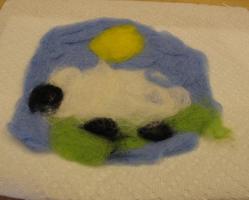 Squeeze out excess water by rolling felt picture in a towel.
Squeeze out excess water by rolling felt picture in a towel. - Lay flat on paper towels to dry.
- Be sure to label children's creations on the paper towel.
- Children can take their felted pictures home although they will need to dry for about 24 hours.
Directions - Cookie Cutter Felted Sheep (younger grades):
- Place the cookie cutter in the bottom of the plastic container.
- Pull off small pieces of wool roving (children may want to make white or black sheep, or colorful "rainbow" sheep).
- Place the wool roving inside the cookie cutter -- completely filling it to the top and making sure all the nooks and crannies of the cookie cutter are filled. Try to keep the roving inside the cookie cutter -- not letting any spill outside the edges or underneath the cookie cutter at the bottom.
- Next gently add hot, soapy water (from the water bottles) to the container until the wool is completely saturated. You may need to pour some directly onto the roving inside the cookie cutter.
- Hold the cookie cutter in place with one hand and have children use the fingers of their other hand to poke up and down for about five minutes until the wool has become firm and felt-like.

- Remove the cookie cutter and felt sheep from the container and rinse well in very warm and then cold water.
- Press into a towel to press out excess moisture. Set on a paper towel to dry. Be sure to label children's creations on the paper towel.
- Once dry, use the needle and embroidery floss to create a hanging loop in the top of the sheep.
Reflection and Journal Time
The last ten minutes should be reserved for Journal Reflection Time. This is an opportunity for processing and reflection about what children have learned.
Journal Questions:
- Grades K-1: Draw a loving shepherd with his sheep.
- Grades 2-4: Imagine you were David singing to your sheep. What song would you sing to them?
- Grades5-6: When have you experienced God as a shepherd in your life?
Clean up
Gather all supplies and encourage each child to clean his/her own work area.
Closing:
Gather the children together before leaving. Review with them one word or concept that they learned (sheep, shepherd, lead, guide, love). Ask for prayer requests and pray together.
A lesson written by Jaymie Derden from: State Street UMC
Bristol, VA
A representative of Rotation.org reformatted this post to improve readability.

